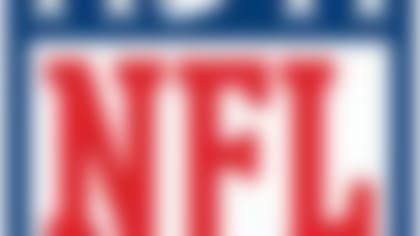NFL Media's Albert Breer touches on multiple topics in his robust Inside the NFL Notebook, including (click on each link to go directly to the topic):
» The Bengals' strategy for replacing Geno Atkins.
» Reasons to think Jason Garrett is probably safe.
» A closer look at recent trends in coaching hires.
» And much more, beginning with a look at one player's historic return from injury ...
If you want to know how Peyton Manning reached 51 touchdown passes and topped 5,000 yards in a single season for the first time in his illustrious 16-year career, his fall practice schedule might provide some insight.
Although he hasn't missed a meaningful snap in a game this season, the Broncos quarterback's right ankle injury limited him in some of Denver's October and November workouts and kept him out of others.
For most 37-year-olds, that's run-of-the-mill mid-season maintenance. Many even want it that way.
But not Manning.
"We did it to make sure he didn't hurt himself by going too far," Broncos executive vice president of football operations John Elway said Monday. "He'd run himself into the ground if we'd let him. So we had to pull him back. 'Greek' (Denver head athletic trainer Steve Antonopulos) did a great job explaining the benefits of not taking every rep. ... We pulled him back because 100 percent of the time he's out there, he's playing it like it's a game situation."
The lesson here: This legendary quarterback -- with a Super Bowl MVP and four regular-season MVPs, a place in Canton all but secure, and all the major passing records in plain sight -- doesn't even take it easy in practice. Manning, who's been through four neck surgeries and came out the other side an All-Pro again, needed to be physically restrained so that he wouldn't overdo it on an ankle sprain.
It's been five days now since Manning reclaimed the single-season touchdown-pass recordTom Brady wrested from him in 2007. In two days, Manning will likely get the 266 yards he needs to break Drew Brees' 2011 yardage record (5,476). And the Broncos quarterback has done it with a cold efficiency that can make one forget how remarkable it is that he's even playing anymore.
Manning's journey back relates, yes, to that relentlessness of October and November. But it's more about how it was applied in the long days of late 2011 and early '12 than anything that's happened in the past few months.
Those closest to him won't ever need a reminder of how he navigated that road. On Tuesday morning, Duke coach David Cutcliffe, Manning's offensive coordinator at Tennessee, was driving on Route 751 to his home in Durham, N.C. -- and all it took was the pavement in front of him to spark memories of the darkest time.
"I'll be honest -- I was shocked at how significant the injury was," Cutcliffe said. "What he looked like physically, without his shirt on, I had the same question he did. And on this very road, he asked me, 'Should I even try to do this?' And after a couple weeks, I'm wondering if I'm at the point where I just say to him, 'Golly, Peyton, think of all you've done. You wouldn't have to worry about it at all.' "
Instead, Cutcliffe reminded Manning there was still time before he'd have to take the field -- it was November 2011, and Manning wouldn't have to be ready until September 2012 -- and so he should just focus on getting well first. And while there was plenty of room for doubt, Cutcliffe said that after Manning got started, "even my 13-year-old daughter, and she was 11 then, could recognize the work, and once he made his mind up, nothing has surprised me."
Within Manning's own family, it's not the touchdown passes or the yards or even the wins that will burn deepest in their memories. Not by a long shot.
"As parents, when we look at the big picture, we remember those months, we're so grateful he's playing again," Archie Manning said Thursday. "When he told us the doctors had cleared him, and he was gonna give it a shot, we knew how bad he wanted to play. So we just wanted him to play. We never had any vision of anything like this. He's always played at a good level, and I knew he wouldn't play long if he couldn't play at a good level. Peyton would recognize that.
"But to have this kind of success, it really has been a blessing. I never thought it'd happen."
Elway entered into the picture later. Though Manning wasn't quite yet himself, he was ready to throw and help lead a practice in the spring. He was ready to get back to the grind of his life's work. And while others seemed to know at that point that Manning would find his way, the old Broncos legend still hadn't seen why.
He found out quickly.
Silver: Manning's the man

"I would tell you that I'm most impressed by his work ethic," Elway said. "You think you know how much it matters to someone until you get up close. He's played so long, and it's just as important now as it was when he was in his fifth year. And his attention to detail, how he goes about his week, I can't imagine he ever worked harder than he does now, because he's 110 percent all in."
Elway said Manning asks his fellow Broncos quarterbacks to check out the TV copy of the game tape to make sure he didn't miss anything. That, of course, is always the idea.
"Peyton loves to play -- God, he loves to play," Archie said. "I've seen him, and when I'm there, it's how excited he is to go to the facility at 6 a.m. He loves everything about it. He loves the locker room. He loves practice. He loves to watch film. He loves to be around his teammates. He loves the offseason program.
"That was the thing with Olivia and me. He told us, 'If it does work out, I'm gonna look back and say it's been a good ride.' But we knew he wasn't ready (to end his career)."
Easy to say now that Peyton's parents were absolutely right. And the Broncos' training staff sure can attest to that.
NFL still adjusting to a new reality
We still don't have a full and fair picture of the most recent collective bargaining agreement, and we won't until the new TV dollars go into the salary-cap equation starting in 2015.
But there's plenty of grumbling around the league that the "parity" in the AFC and most of the NFL would be better described as mediocrity resulting from changes that went into effect in 2011. Some of it is related to economics; some of it can be linked to the work rules.
Those two issues, of course, tie into one another. With blue-chip (and, in particular, quarterback) salaries continuing to rise, and with minimums also going up, the middle class has gotten squeezed. That means teams are carrying younger players who need time to develop -- time their bosses no longer have.
"There's less veteran depth than before," one NFC team exec said. "I don't think that means you're less talented, but it's less-experienced talent. How do you make up for that? Well, the work rules have prohibited doing more work in the offseason, so you're learning on the job more.
"Now, the real question comes in two, three years, when younger guys get that experience. We're still in a transition period. It's not a great predictor of change. In two, three years, they'll have experience and the cap will grow."
One area to watch will be the fundamental development of new pros. Given the limits, both in terms of on-field time and the number of padded practices, coaches have to be more judicious in cordoning off the minutes and hours they have with their players. And those decisions can have wide-ranging effects.
"Limited practice time and coaches' love of scheme have made (organized team activities) all about installation of plays and very little about skill development," one AFC general manager said. "OTAs were supposed to be for fundamental improvement, but they turned it into a time crunch, with how many plays we can run. (There's) a lack of fundamental development, and it shows on the field. And a lot of high-intensity OTA reps squeezed in a short period of time leads to more injuries."
Earlier this week, the NFL sent a memo to its Health and Safety Advisory Committee explaining that injury totals are lower or comparable to the past two seasons. But the numbers only accounted for ACL and MCL sprains suffered from the preseason through Week 13, not those that were suffered in offseason practices. On Tuesday, Bill Belichick echoed what the AFC GM said, making the point that with less time, players are more prone to getting hurt.
That's just a snapshot of the larger debate brewing as to how this will all play out over the long term. Fact is, we're still in the middle of the adjustment, with teams and players trying to determine how to operate most efficiently under the circumstances.
One other thing to watch here: How it affects the hiring cycle. Most NFL folks aren't surprised that coaches coming from the college level, like Pete Carroll, Jim Harbaugh and Chip Kelly, have been able to adapt their programs fairly seamlessly within the parameters, because they all dealt with the 20-hour rule in college and needed to be creative (i.e. Kelly's short but supersonic, rep-heavy practices) with their time.
That might make a coach like Penn State's Bill O'Brien even more attractive as NFL jobs begin to open up next week.
How the Bengals managed without Geno Atkins
While we're on the subject of injuries, I can't remember going into playoff time with a circumstance like what we have in the AFC right now: Each division winner has a franchise player (or three) on injured reserve. Denver (Ryan Clady, Von Miller), New England (Vince Wilfork, Jerod Mayo, Rob Gronkowski), Cincinnati (Geno Atkins, Leon Hall) and Indianapolis (Reggie Wayne) have had to adapt accordingly. And the Bengals' approach for replacing their highest-paid -- and perhaps best -- player has them playoff-bound ahead of Sunday's game against Baltimore.
Going into Halloween night in Miami, the Week 9 matchup in which Atkins tore his ACL, the Bengals ranked eighth in total defense (322.5 yards allowed per game), eighth against the run (97.3 yards per game) and 11th in pass defense (225.3 yards per game). Remarkably, in the two months since losing its monster in the middle, Cincinnati has improved to fifth in total defense (311.1 yards per game), ranking sixth against both the run (99.8 yards per game) and pass (211.3 yards per game).
"The first part is getting over the initial shock," said Bengals defensive coordinator Mike Zimmer on Thursday. "The players know when a guy is a super player, so part of it is just getting over it. Then, the next part, what we try to do is not just make sure the players we bring in to replace them are being used to their strengths, but also that we're accentuating other good players: (Carlos) Dunlap and (Michael) Johnson, (Domata) Peko and (Vontaze) Burfict.
"We don't worry about the past. We tried to isolate Geno a lot. Well, now that's done, and we have to find ways to use other guys in a way where they can become a factor."
In their base defense, the Bengals have moved Brandon Thompson, a 2012 third-round draft pick, into Atkins' spot, asking the former Clemson defensive tackle to play the role of 325-pound run-stuffer. On third downs and in long yardage, James Harrison is seeing the bulk of Atkins' snaps, though in a little bit of a different role. Zimmer said the scheme hasn't needed to be adjusted at all on run downs, but the Bengals have become a little more exotic in passing situations.
The key hasn't been to try to turn one player into Geno Atkins. It's been to piece things back together by using each player within his own limitations.
"Yeah, we asked more (of Thompson), but by the same token, we're not asking him to do things he can't do," Zimmer said. "We understand he's not the pass rusher Geno was, and we can't expect the same production, pass-rush-wise. So it was, 'Here's what he does good, he can contribute doing that, and he'll work on his pass-rush technique and help there when he has to.' It'd be crazy to think we could make him into Geno Atkins."
And so the Bengals have survived. With the AFC North locked up, they have a chance to atone for past playoff failures.
Zimmer's success adjust to Atkins absence underscores why a lot of NFL folks think Zimmer will become a heck of a head coach someday; he's able to evaluate his own players and maximize every one of them within the context of his scheme. That's pretty much what coaching is, right?
Four downs
1) Changes coming in Big D? Some have surmised that, without Tony Romo on the field Sunday,Jason Garrett's job will ride on the right arm of journeyman Kyle Orton. I look at it differently. In fact, my sense is that this whole circumstance provides an "out" for owner Jerry Jones in the decision-making process. But before we get to that, it's vital to understand the investment that Jones and his family have made in Garrett's growth in the position he now holds. Firing Garrett wouldn't be like firing Dave Campo or Wade Phillips or Chan Gailey -- not by a long shot. Garrett was allowed into the Cowboys' game-plan meetings as a backup quarterback in a career-development effort by the team. He was hired as Dallas' offensive coordinator before Phillips was tapped to replace Bill Parcells in 2007. And when Baltimore and Atlanta started buzzing around Garrett in 2008, Jones gave him an eye-popping $3 million per year to stay on -- the owner actually had to give Phillips a raise to ensure the head coach would remain the highest paid guy on the staff. For all those reasons, the acknowledgement of Garrett's failure as head coach, via a termination, would be an admission by Jones of his own failure in identifying him so long ago for that role. Jones has said repeatedly, going all the way back to the spring, that Garrett isn't coaching for his job. But my belief is that missing the playoffs for a third straight year might've forced the Cowboys' hand. Now, though, with Romo's injury, it would seem that Jones has a pretty valid reason to avoid doing something he likely really doesn't want to do.
2) Minnesota shakeup on the way? Let's start here: It's pretty easy to respect the calm that Leslie Frazier has shown through a nightmare of a season. When I asked him if he felt he was coaching for his job last week, he answered this way: "I don't. I'm gonna approach things like I did six weeks ago, eight weeks ago, try to get our guys ready to play. The same motivation I had then is the same motivation I have now." And that motivation, he said, is simply being a pro and having pride in what you do. The move coming here isn't about that. It is, more likely, about a franchise that is working on a billion-dollar project and, as a result, is on the clock. By the time the Vikings' new stadium opens in 2016, ownership will likely want to have made up its mind as to whether GM Rick Spielman -- who has been the franchise's top personnel man since 2006, earning the GM title two years ago -- is the guy to lead the franchise forward. Those owners are now almost certain to give Spielman the chance to hire his own coach and make up for the swing-and-miss on Christian Ponder at quarterback -- albeit with a shorter leash than they allowed before.
3) Jets' decision on Ryan will reach beyond 2013. The mistake many people make in assessing coaching movement around this time of year is assuming that the NFL is some sort of meritocracy. Lovie Smith didn't necessarily deserve to be fired last year in Chicago after missing the playoffs with a 10-6 mark. It's just that GM Phil Emery had been promised, upon taking the job in 2012, that he could make a decision on Smith's future following that season. The ultimate call was made not for 2013 but more for the long term. Jets GM John Idzik doesn't have the power Emery did last year, as owner Woody Johnson will have the final say on Rex Ryan's status. It's easy to argue that Ryan, in getting to 7-8 amid a cap purge and a front-office overhaul, deserves to be back in 2014. But as was the case with Smith in Chicago in 2012, that's not what it's about in New York this year. Further pushing decision-time is that Ryan has a year left on his deal, meaning the Jets have reached a contractual fork in the road. When Johnson sits down to finalize a call that I believe he's had in mind for a while, it'll be about the relationship between Idzik and Ryan and whether or not Johnson sees the franchise as one that is in alignment philosophically. And if Johnson thinks it's not, well, it'd be hard to blame him for pulling the trigger, no matter how good a job Ryan has done.
Battista: To play or not to play?

4) What Rodgers' return means to the Packers.Since Aaron Rodgers broke his collarbone in early November, the Packers have started three different quarterbacks -- and they didn't just miss the production they were used to getting from that particular spot. At the time of the injury, coach Mike McCarthy took me through the process he goes through in meeting with his quarterback every day, as he planned to do with then-starter Seneca Wallace: "I do the same thing with Aaron every single week. I've done it with every quarterback I've ever coached. ... You do it as it goes in. Wednesday, normal down-and-distance and third-down go in, so you clean that up. Then, red zone, you clean it up. And you keep massaging it all week. And then tomorrow we'll have our last final run-through, and if there's any blinking, it'll come off the sheet." Now, fully process what McCarthy said, and imagine just how much "blinking" there likely was for Wallace or Scott Tolzien or Matt Flynn -- none of whom were in camp with Green Bay -- versus how much there normally is with Rodgers. It's mind-bending to think of how much less, particularly in a complex scheme, the Packers were capable of over the past seven games. It probably makes the idea of Rodgers' return absolutely tantalizing for the other 10 guys in the Green Bay huddle -- and pretty daunting for the Chicago Bears.
Three checkdowns
The playoff picture

How would your team's prospects look if the season ended today? See where each team stands in the playoff picture midway through the season. **More ...**
1)Chicago Bears defensive tackle Henry Melton has pretty much written a guide over the past calendar year on the pitfalls of the franchise tag, first tearing his ACL, then getting involved in an altercation at a bar last week. It'll be interesting to see how the 27-year-old is treated on the open market in March.
2) With the Bills working through rookie quarterback EJ Manuel's second significant injury of the season, it'll be interesting to monitor how they address depth at the position in the offseason. Remember that technically, Manuel was the final first-round pick of the Buddy Nix regime in Buffalo.
3) The concussion issue has been an across-the-board problem, but it seems to be an epidemic for slot receivers. Wes Welker is fighting through issues, as Brandon Stokley and Wayne Chrebet once did, and that leads to questions about the small, shifty ones navigating the land of giants.
Two college players to watch this week
1) Louisville QB Teddy Bridgewater (Russell Athletic Bowl, vs. Miami, Saturday, ESPN, 6:45 p.m. ET): With nearly 10,000 yards, 69 touchdowns and just 24 interceptions in the books, Bridgewater wraps up his third -- and quite possibly final -- season for the Cardinals against his hometown Hurricanes. And there's plenty of good to see here. But there are questions, too. "He's accurate, poised, smart, productive," said one AFC college scouting director. "The body type is the concern. You're gonna have to see him at the combine. He looks small and skinny to me. But he gets rid of the ball so quick and makes such good decisions, maybe you can live with that. If I had the first pick, I don't know that I'd see it, but if you're comfortable with his body, I can see where you would do it." Another AFC college director called Bridgewater, "a second-rounder. Shorter and smallish in size, but he has solid arm strength, he's a good athlete, solid accuracy. Not dynamic or a special talent, but he has NFL starter-caliber skills, and he's a good kid with all the intangibles." Basically, what you can surmise there is that the eye test, and what Bridgewater physically looks like in front of evaluators, will make all the difference. Louisville lists him at 6-foot-3 and 205 pounds -- and if you know anything about how football coaches do measurements, you know it's a good bet he's at least a little shorter and lighter than that.
Ranking the bowl teams' prospects

From Alabama all the way down to Navy, Bucky Brooks ranks every bowl team -- all 70 of them -- based on the quality of each team's top NFL draft prospects. **More ...**
2) South Carolina DE Jadeveon Clowney (Capital One Bowl, vs. Wisconsin, Wednesday, ABC, 1 p.m. ET): So we're through the season and we haven't spotlighted Clowney yet? Uh, whoops. The South Carolina star has been good but not great in 2013, with his numbers significantly down from 2012 in just about every major statistical category. "He's flashed that big-time ability, but that's easy, because he has that," said the second AFC college director. "Very average production, average overall season, but he's still talented enough so that offenses focus on him." And all that will raise the great debate on this particular player over the next few months, which will lead to the central question asked by scouts: How passionate is Clowney about football? "There are two ways of thinking about it," said the first college director. "You could say, now, he's just going to playing the game, he doesn't need to worry about not getting hurt and making it anymore, and he'll feel more comfortable now that it's football only and he won't be concerned about the draft and he can just play ball like he did his first two years. Or you could say, 'Now that he's getting paid, is he gonna coast?' That's the question you have to answer." So in a way, what's coming with Clowney isn't so much a skills assessment as it is a psychological evaluation.
Extra point
With the coaching hiring cycle about to rev up, it's worth looking at one trend that was pronounced in 2013 and is something that we'll all be watching again: The propensity of owners to hire guys with offensive backgrounds.
Last year, seven of the eight guys hired had backgrounds as offensive play-callers, way up from 2012 (two of seven) and 2011 (four of eight). Given the importance on quarterback development and the passing game, the trend will probably continue, with names like Bill O'Brien and Darrell Bevell and Greg Roman likely to dot the landscape.
Billick: Cases for coaches under fire

With Black Monday nearing, Brian Billick lays out the reasons that several coaches on the hot seat should keep their jobs. **READ**
But should it be that way?
Well ... let's go back 10 years. A guy with a special-teams background (John Harbaugh) won it all last year. A former receivers coach-turned-college head coach (Tom Coughlin) has won two titles in that time, while a secondary coach who spent just a single season as a defensive coordinator (Mike Tomlin) has won one. A couple of guys with strong backgrounds as offensive coordinators (Sean Payton, Mike McCarthy) went back-to-back in '09 and '10, but similar defensive types (Bill Cowher, Tony Dungy) did the same in '05 and '06.
And then, of course, the champion in '04 -- and in '01 and '03 -- was another coach with a defensive-heavy background: Bill Belichick. That guy is still doing pretty well for himself, having found a way to develop a quarterback and cobble together an offense despite never having been an offensive coordinator.
That, at least, should serve as a reminder to those doing the hiring over the next couple of weeks that setting rigid criteria for what the next head coach needs to be might not be the best idea in the world.
Follow Albert Breer on Twitter @AlbertBreer.



